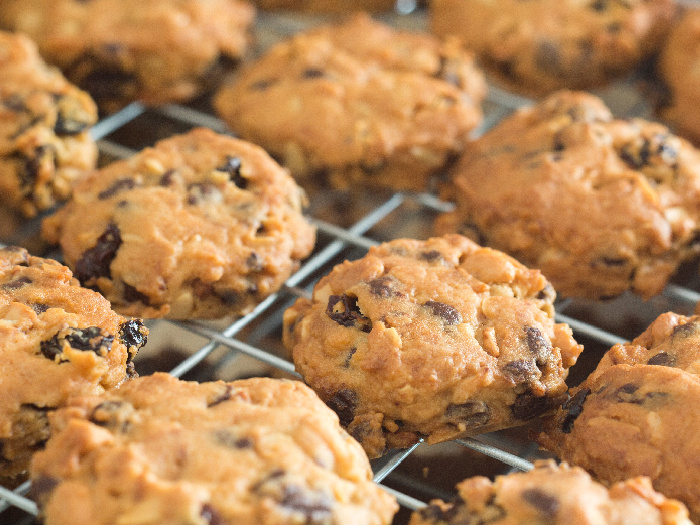From the delicate and exquisite little morsels at a French pâtissière to your granny’s old pie, baking has always been part of our collective gastronomical experience. The magic of baking lies in its ability to raise dough, make it airy and light or in combining a fairly tasteless looking gruel into a mouthwatering cake. The revival in baking has come about thanks to cookery shows and the explosion of food bloggers. Suddenly, recipes and ingredients from across the world are available to us and we are showing our love by baking with new flours, sugars, fruits, syrups, vegetables, cheeses and anything else we can find.
The rise in interest in baking can also have a positive effect on our mental well-being. While eating has been associated with anxiety, the art of making the food, ironically, is now seen as its antidote. In 2018 the literary and cultural magazine The Atlantic, coined the term ‘anxiety baking’ as a way of countering rising cases of anxiety among Americans. In an article that explored the recent trend of baking among millennials, the writer found that many people are taking up baking to express their creativity or to escape stress. [1]
The association of baking and mood has been captured by many chefs as well. Specialist food creative consultant Emma Thomas, based in the UK, organizes Depressed Cake Shop to raise awareness on mental health disorders. Aimed to create a worldwide community, it uses creativity to promote self-care. John Whaite, the winner of the third series of The Great British Bake Off, has vividly linked his moods and feelings with baking in his book John Whaite Bakes: Recipes for Every Day and Every Mood. “I bake because it is a form of a comfort blanket, and because it is a form of artistic expression for me”. [2]
What Is Baking?
Baking is a method where dry heat is used to cook food. The most familiar form of baking is through an oven. But we can also use hot stones, coals or ashes to achieve the same effect. Baked products are a part of almost every culture. It has not only survived but also evolved and thrived over centuries. Some ancient methods have remained unchanged, some have evolved and some are lost. But baking remains one of the most common methods of cooking our food since ancient times.

Baking ingredients Photo Credit: Shutterstock
The origins of baking may even predate fire when the ancient man used hot rocks to cook food. The revolution in baking really occurred after the invention of the enclosed oven, more than 6500 years ago in Croatia. Different civilizations, from the Greek to the Egyptians used the method to cook food. But it seemed to have thrived under the Romans. With its spread and influence, baking as we know it today, also spread to different parts of the world with the Romans.
Techniques of baking
What makes baking different from any other form of cooking is its precision. It is a science that must be approached in the right manner. This is why a recipe is so important in baking. Too few eggs and your cake will be hard, too much flour and it won’t rise. If the dough is not rested enough, your bread will not rise. So, here are a few techniques that are common in baking:
- Blind baking: You will often see this term in pie recipes. It means pre-cooking the pastry before adding the filling. The usual practice is to line a baking tin with the pastry, prick it, and then fill it with dried beans or rice. Apart from cooking the crust, blind baking prevents the crust from getting soggy.
- Creaming the butter: Many cake recipes start with creaming the butter. It simply means beating the butter until it becomes creamy and light. Once the butter is beaten, sugar is added and again beaten through. This allows the sugar to be properly incorporated.
- Rub in method: Pastry recipes will ask you to ‘rub in the butter’. It means rubbing in the butter into the flour. The butter should be chilled and it must be mixed in quickly to ensure that the butter stays as cold as possible. The butter is cut into small pieces and then ‘rubbed’ along with the flour till it resembles breadcrumbs. This is the best way to ensure that butter is properly incorporated in the flour.
- Lining/greasing/flouring the tin: When a recipe asks you to line a tin, it simply means covering the tin with a baking paper. Greasing a tin means applying a film of butter, oil, or shortening on its inner surface. Sometimes a recipe will ask you to ‘flour the tin’ after greasing it. It means covering the tin surface with flour before pouring in the batter. These methods are used to ensure that the baking mixture does not stick to the tin.
- Measuring the ingredients: It is imperative that you measure your ingredients exactly as per the recipe. When measuring flour or sugar with a cup, use a knife to make sure that the surface is level. Similarly, when measuring liquid, make sure it is up to the brim of the measuring scale, cup, or spoon.
Common Baked Items
We are surrounded by baked food around us. Some of the most common baked foods are:
- Bread: It is one of the oldest and most common baked dishes. Bread is the staple food in many cultures. Although we mostly think of bread in terms of loaves and slices, there are also flatbread versions, such as rotis, pita bread, lavash, and of course, pizza. The common ingredient in every bread is flour and water to knead it. Most bread recipes also use yeast for leavening the flour.
- Cake: Whether it’s a celebration, a party, or tea, a slice of cake can make any meal special. Cakes can be simple or made special for a celebration. They can be airy and light or dense and gooey. Unlike bread, cakes are sweet and usually use baking powder for leavening. Celebratory cakes use frosting, icing, fondants, and other means for increasing the visual appeal. Variations of cakes include cupcakes and brownies.
- Pie: Pies can be sweet or savory. They fall under four different categories, cream, fruit, custard, and savory. The usual recipe for a pie requires a pie crust that contains some kind of filling. Pies can be open, covered or partially covered. Popular pies include cheesecake, apple pie, pecan pie, cream pie, Missipie mud pie, banoffee pie, and pumpkin pie. A tart is a popular variation of the pie.
- Cookies/Biscuits: These are the two sides, or rather the Brit-American version of the same thing. Cookies are generally small, flat, and sweet. Recipes are usually dependent on the type of pastry you are working with. It could be a simple dough, a shortbread pastry or a slightly more complicated puff pastry.
Basic Equipment You Need For Home Baking
Many people are under the mistaken impression that they need a number of things to be a competent baker. But you can be a fairly competent baker with just an oven. In case you are serious about baking, here are some tools and equipment you should invest in:
- Oven: An enclosed oven is one of the most essential tools in baking. It allows you to control the temperature and ensure a more even cooking. But if you don’t have an oven, there are other alternatives you can try. Anything that can trap dry heat in a small space can work like an oven. These include a microwave oven, instant pot, and air-fryer. Traditional ovens use a small masonry chamber where wood or ash is used to heat the interior.
- Whisk: A basic balloon whisk can help you whip up eggs quickly. An electric whisk will help you save the time and effort it requires to whisk eggs and batters. If you can splurge and bake regularly, a stand mixer is a great idea. You don’t even have to hold the whisk while the machine whips up airy eggs or works your dough in a matter of minutes.
- Food processor: Although not essential, food processors can help you when a recipe asks for grated or pureed ingredients. The all-in-one-method, such as in cheesecakes, can be finished wonderfully in the processor.
- Baking tins: Aluminium is considered the best material for a baking tin because it allows for a quick transfer of heat. Other materials available today include non-stick versions and silicon pans. There are innumerable shapes available. The most basic tins that you should get are sheet, loaf, round, rectangular, spring-form, and cupcake tins.
- Spatula: A spatula is the tool of choice when creaming butter. It may come in even more useful than a whisk. It also helps you in scraping the baking bowl when transferring the batter to the baking tin.
- Measuring tools: Since proper measurements are essential, consider investing in measuring tools like kitchen scale, measuring cups and spoons.
In many cultures, there is a tradition of a community oven where everyone can bake their bread. In the book Traditional Foods: History, Preparation, Processing and Safety, the author mentions the traditional practice in the rural Maghreb where a community oven is used to bake flatbreads for the whole community. Similarly, Tambo: Life in an Andean Village, talks of a community oven in a Peruvian village where bread is baked for everyday use and during festivals. [3] [4]

